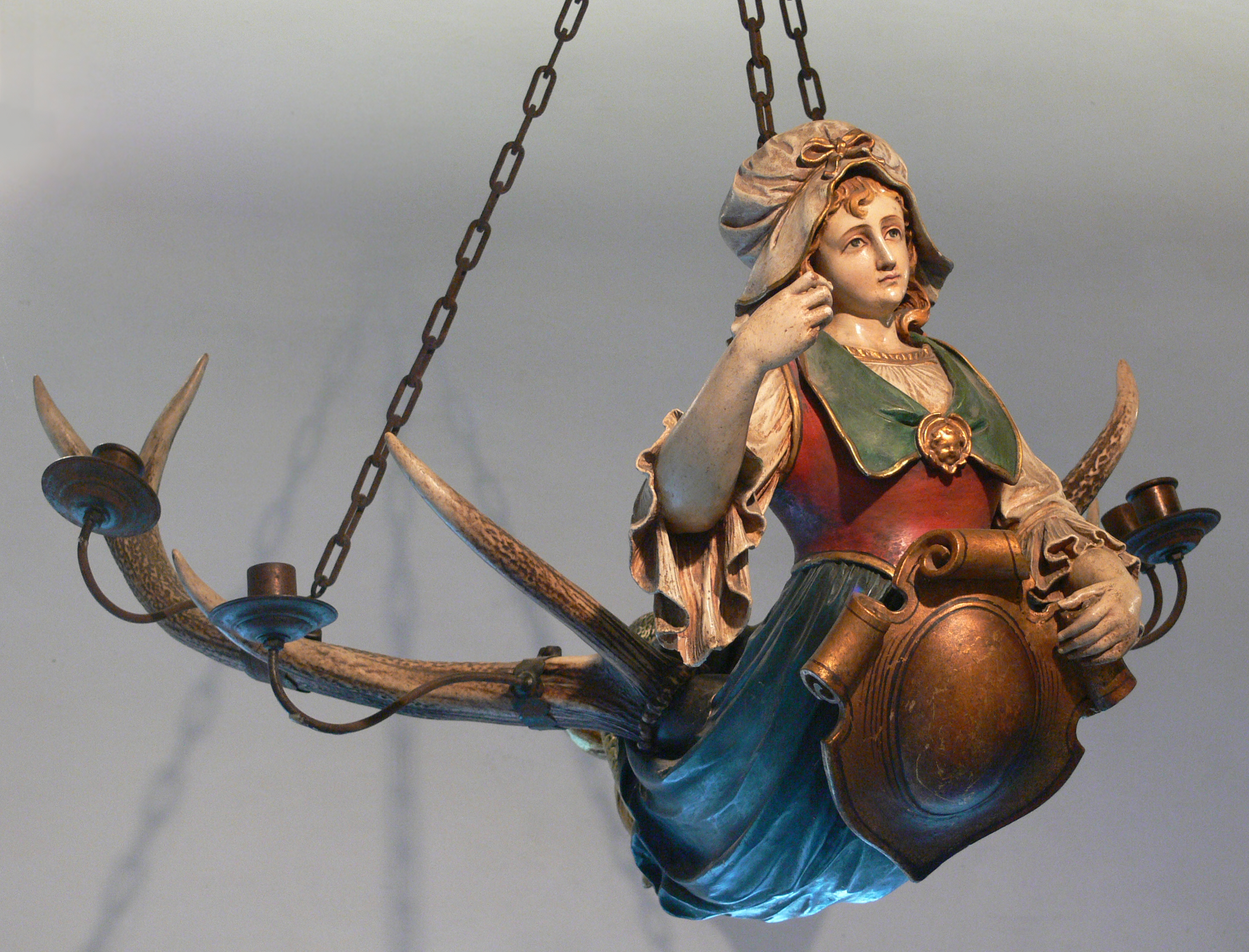Lusterweibchen on:
[Wikipedia]
[Google]
[Amazon]
 Lusterweibchen is a style of
Lusterweibchen is a style of
Anthropomorphic Chandeliers of the 15th-17th Centuries
scans of historical pictures of lusterweibchen catalogues
{{Commonscat, Lüsterweibchen, Lusterweibchen Furniture Types of lamp
 Lusterweibchen is a style of
Lusterweibchen is a style of chandelier
A chandelier (; also known as girandole, candelabra lamp, or least commonly suspended lights) is a branched ornamental light fixture designed to be mounted on ceilings or walls. Chandeliers are often ornate, and normally use incandescent ...
. It has a horizontal antler fixed with a carved wooden sculpture. The German term “''Lüsterweibchen''” (''little woman chandelier'') refers to the sculpture, while the lamp itself is categorized as a type of horn furniture
Horn furniture is a name given to furniture which is manufactured completely by shed antlers or pieces of furniture such as e.g. cabinets which are appliqued with antler elements such as carved horn roses or with antler pieces from tusks, fallo ...
.
History
The first chandeliers in the lusterweibchen style appeared at the end of the 14th century. The Marienkirche inLemgo
Lemgo (; nds, Lemge, Lemje) is a small university town in the Lippe district of North Rhine-Westphalia, Germany.
It is situated between the Teutoburg Forest and the Weser Uplands, 25 km east of Bielefeld and 70 km west of Hannover. ...
, Germany
Germany, officially the Federal Republic of Germany (FRG),, is a country in Central Europe. It is the most populous member state of the European Union. Germany lies between the Baltic and North Sea to the north and the Alps to the sou ...
, was illuminated by a chandelier that combined a bust of a woman with a pair of 12-point deer antlers. The artist of this particular piece is unknown, but the extraordinary chandelier inspired many other artists to create their own works.
During the 16th century lusterweibchen chandeliers boomed, with famous designs by artists such as Albrecht Dürer, Veit Stoss
Veit Stoss (also: ''Veit Stoß'' and ''Stuoss''; pl, Wit Stwosz; before 1450about 20 September 1533) was a leading German sculptor, mostly working with wood, whose career covered the transition between the late Gothic and the Northern Renaissa ...
, and Tilman Riemenschneider
Tilman Riemenschneider (c. 1460 – 7 July 1531) was a German sculptor and woodcarver active in Würzburg from 1483. He was one of the most prolific and versatile sculptors of the transition period between late Gothic and Renaissance, a master ...
. They may have had an almost magical appeal, reflecting the spirit of the era. The most famous lusterweibchen design was a dragon chandelier carved by Veit Stoss according to a drawing by Albrecht Dürer.
As an element of horn furniture, antlers are treasured by collectors and well suited for display. The combination of antler and a carved statue resulted in a perfect unit for decoration and room illumination. With the rising prosperity of the European middle class at the end of the 19th century, lusterweibchen chandeliers became an established design feature.Werner Dettelbacher: Meister Heinz Schiestl: Ein Würzburger Bildhauer, Verlag Ingrid Beck (1990) Artists created various designs ranging from copies of old drawings to busts of contemporary noblewomen, mermaid
In folklore, a mermaid is an aquatic creature with the head and upper body of a female human and the tail of a fish. Mermaids appear in the folklore of many cultures worldwide, including Europe, Asia, and Africa.
Mermaids are sometimes asso ...
s, Diana
Diana most commonly refers to:
* Diana (name), a given name (including a list of people with the name)
* Diana (mythology), ancient Roman goddess of the hunt and wild animals; later associated with the Moon
* Diana, Princess of Wales (1961–1997) ...
s, coats of arms
A coat of arms is a heraldic visual design on an escutcheon (i.e., shield), surcoat, or tabard (the latter two being outer garments). The coat of arms on an escutcheon forms the central element of the full heraldic achievement, which in it ...
, guild
A guild ( ) is an association of artisans and merchants who oversee the practice of their craft/trade in a particular area. The earliest types of guild formed as organizations of tradesmen belonging to a professional association. They sometimes ...
emblems, and lustermaennchen featuring male figures.
References
External links
Anthropomorphic Chandeliers of the 15th-17th Centuries
scans of historical pictures of lusterweibchen catalogues
{{Commonscat, Lüsterweibchen, Lusterweibchen Furniture Types of lamp